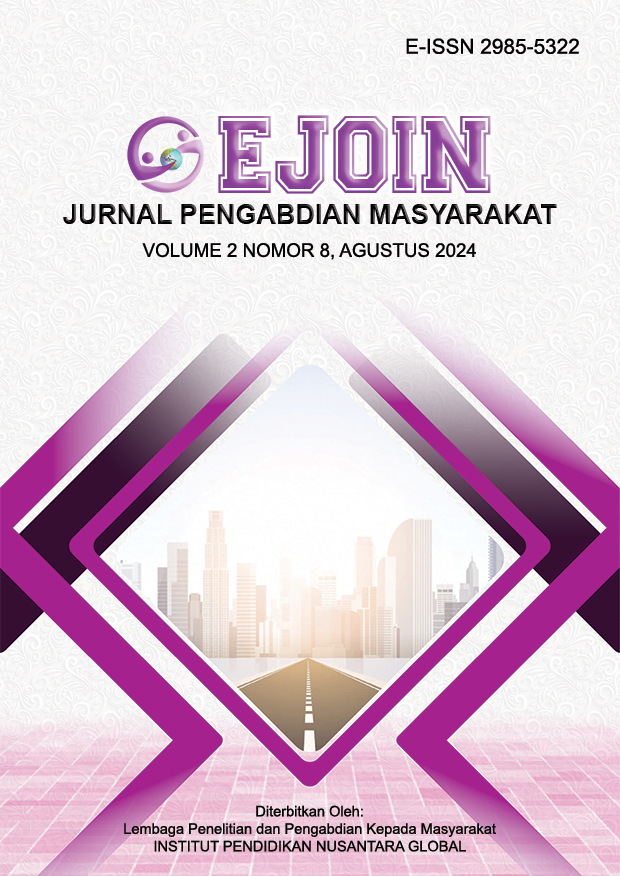KELURAHAN PETANI HIJAU MODERN: SMART FARMING MENGGUNAKAN TEKNOLOGI PANEL SURYA UNTUK MEWUJUDKAN KAWASAN PERTANIAN MODERN DI KELURAHAN BAKUNG JAYA
Keywords:
Pemberdayaan Masyarakat, Hidroponik, PLTS, SprincleAbstract
The development of automatic plant watering devices has become a major focus in increasing efficiency and effectiveness in plant cultivation. In this context, automatic plant watering devices that use electrical energy sources from solar panels have shown great potential in saving energy and reducing environmental impacts. This tool is designed to replace manual work in watering plants, both in hydroponic systems and sprinkler systems. In hydroponic systems, automatic plant watering devices use soil moisture sensors to detect soil moisture and send commands to the water pump to water periodically. This allows hydroponic plants to receive nutrients continuously and maintain air humidity with automatic fogging. Meanwhile, in sprinkler systems, automatic plant watering devices use solar panels as a source of electrical energy. These solar panels generate electrical energy that is used to power the water pump and sprinkler, thus watering plants automatically without the need for human intervention. The advantages of using solar panel in automatic plant watering devices include the use of renewable energy, easy maintenance, and no greenhouse gas emissions. However, this tool also has disadvantages, such as dependence on sunlight intensity. Thus, the development of automatic plant watering devices using solar panel can help increase plant productivity, save energy, and reduce environmental impacts. This tool can also be integrated with various types of plant cultivation systems, thus providing many benefits in the development of modern agricultural technology.
Downloads
References
F. Irshadi, F. Adelia Parhusip, C. Nababan, and D. Wahyu Harmoni Sembiring, “Miniriset Hukum Agraria Kepastian Hukum Atas Tanah Kosong di Kota Medan,” Jurnal Relasi Publik, vol. 2, no. 1, pp. 49–62, 2024, doi: 10.59581/jrp-widyakarya.v2i1.2071.
H. N. Setiawan, “INDONESIA DENGAN KONSEP TRADISIONAL AGRARIS,” 2023.
E. Y. DEWI, E. YULIANI, and B. RAHMAN, “Analisis_Peran_Sektor_Pertanian_Terhadap,” KAJIAN RUANG, vol. 2, no. 2, pp. 229–248, 2022.
A. SUWANDI, N. DAULAY, and R. IMNUR, “PERANAN DANKENDALA PENGEMBANGAN AGROINDUSSTRI DI INDONESIA,” INOVASI PENELITIAN , vol. 2, no. 10, pp. 3185–3192, 2022.
“Yoniansyah+2”.
P. Hariyadi and A. Editor Muh Arman Ya min Pagala, STRATEGI AGRIBISNIS, 1st ed. PAMULANG: PT. GRAMEDIA, 2023. [Online]. Available: www.ut.ac.id.
R. Neto Wuli Sekolah Tinggi Pertanian Flores Bajawa, K. Kunci, M. Sumber Daya Manusia, P. Unggul, and K. Pangan, “PENERAPAN MANAJEMEN SUMBER DAYA MANUSIA PERTANIAN UNTUK MENCIPTAKAN PETANI UNGGUL DEMI MENCAPAI KETAHANAN PANGAN”.
R. J. ZENDRATO, P. H. TELAUMBANUA, and H. P. ZEBUA, “PENERAPAN PERTANIAN ORGANIK DALAM MEWUJUDKAN PERTANIAN BERKELANJUTAN,” SAPTA AGRICA, vol. 3, no. 1, pp. 52–66, 2024.
M. Syaiful Alim et al., “INFORMASI ARTIKEL ABSTRAK,” vol. 4, no. 3, pp. 2427–2435, doi: 10.55338/jpkmn.v4i2.1480.
R. Suwaji, F. Oktafiani, R. Indra Sabella, R. Kurniawati, and S. Tinggi Ilmu Ekonomi YAPAN, “SOSIALISASI LITERASI DIGITAL UNTUK PENINGKATAN WAWASAN DUNIA E-COMMERCE HASIL TANAMAN SAYUR HIDROPONIK,” Communnity Development Journal, vol. 5, no. 3, pp. 5165–5172, 2024.
Downloads
Published
Issue
Section
License
Copyright (c) 2024 Pria Abdilah Hendra, Yosi Riduas Hais, Reza Kurniawan, Teddy Samuel Samosir, Raihan Assyawal, Daffa Dwi Saputra, Carina Cinta Cordelia Simajuntak

This work is licensed under a Creative Commons Attribution-ShareAlike 4.0 International License.









